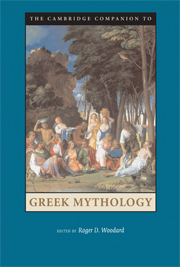Book contents
- Frontmatter
- Introduction: Muthoi in Continuity and Variation
- Part I Sources and Interpretations
- Part II Response, Integration, Representation
- Part III Reception
- 13 Women and Greek Myth
- 14 Let Us Make Gods in Our Image: Greek Myth in Medieval and Renaissance Literature
- 15 'Hail, Muse! Et Cetera'': Greek Myth in English and American Literature
- 16 Greek Myth on the Screen
- Bibliography
- Index
16 - Greek Myth on the Screen
from Part III - Reception
Published online by Cambridge University Press: 28 March 2009
- Frontmatter
- Introduction: Muthoi in Continuity and Variation
- Part I Sources and Interpretations
- Part II Response, Integration, Representation
- Part III Reception
- 13 Women and Greek Myth
- 14 Let Us Make Gods in Our Image: Greek Myth in Medieval and Renaissance Literature
- 15 'Hail, Muse! Et Cetera'': Greek Myth in English and American Literature
- 16 Greek Myth on the Screen
- Bibliography
- Index
Summary
Since Georges Méliès made Pygmalion et Galathée (Pygmalion and Galatea) in 1898, Greek mythology has afforded filmmakers endless opportunities to display their medium to great public success, if at varying levels of artistic achievement. From short films such as those of Méliès at the dawn of cinema to gigantic widescreen and color epics, films set in ancient Greece and Rome have proven most durable for their sheer appeal as spectacles. Critics and historians have come to call them peplums or pepla after peplum, the Latin equivalent of the Greek word peplos(“mantle, cloak ”). But Germans and Italians tend to use an expression that characterizes most of these films even better: Kolossalfilm or il kolossal. Colossal visual pleasures unfolding in splendid if fake-classical architecture and involving invincible heroes, scheming villains, pretty damsels, wily seductresses, and menacing monsters had not been this easily available before. Cinema and its offspring, television, have proven the most fertile ground for reimagining and reinventing antiquity, not least by means of increasing technological wizardry such as computergenerated images. Long-running television series such as Hercules: The Legendary Journeys and its spin-off, Xena: Warrior Princess, animated Disney films such as John Musker and Ron Clements’s Hercules (1997) and its sequels, and big-screen extravaganzas such as Wolfgang Petersen’s Troy (2004) all attest to our continuing fascination with ancient myth.
- Type
- Chapter
- Information
- The Cambridge Companion to Greek Mythology , pp. 453 - 480Publisher: Cambridge University PressPrint publication year: 2007
- 3
- Cited by



